Oriental Roller Pigeon: The Genius of the Sky
The Oriental Roller pigeon is a domestic and fancy bird developed by selective breeding. While the exact origin of this pigeon breed is unknown, it has amassed worldwide popularity due to its incredible aerial tricks.
This capacity to perform somersaults and other acrobatics has turned the Oriental Roller into an ideal bird for show and exhibition.
Oriental Rollers are fascinating birds and breeding them is equally interesting.
Many factors play a role in developing this bird and knowing them is the difference between a successfully bred Oriental Roller pigeon and a failure.
Continue reading as we dig deep into the bird world to talk about one of the world’s most popular roller pigeons.
We will discuss everything about the Oriental Roller pigeon to help you get familiar with it and raise them properly.
Oriental Roller Profile
| Name | Informations |
|---|---|
| Scientific Name | Columba Livia |
| Common Names | 01. Turkish Oriental Roller 02. Flying Oriental Roller |
| Origin | Asia or Middle East regions |
| Size | 40cm |
| Weight | 280 to 400 grams |
| Lifespan | 7 to 10 years |
| Physical Features | Standard |
| Temperament | Calm |
| Behavior | Docile |
| Special Features | Wings kept under the tail |
| Breeding and Maintenance | Easy |
| Common or Popular Varieties | Different colors |
Want to learn more about pigeon breeds:
Overview of Oriental Roller Pigeons
The Oriental Roller is a fancy pigeon breed primarily known for its distinctive flying style. During flight, the pigeon can perform somersaults, rolls, and other aerial tricks.
Therefore, breeders raise these pigeons for their incredible flying skills and aerial performances.
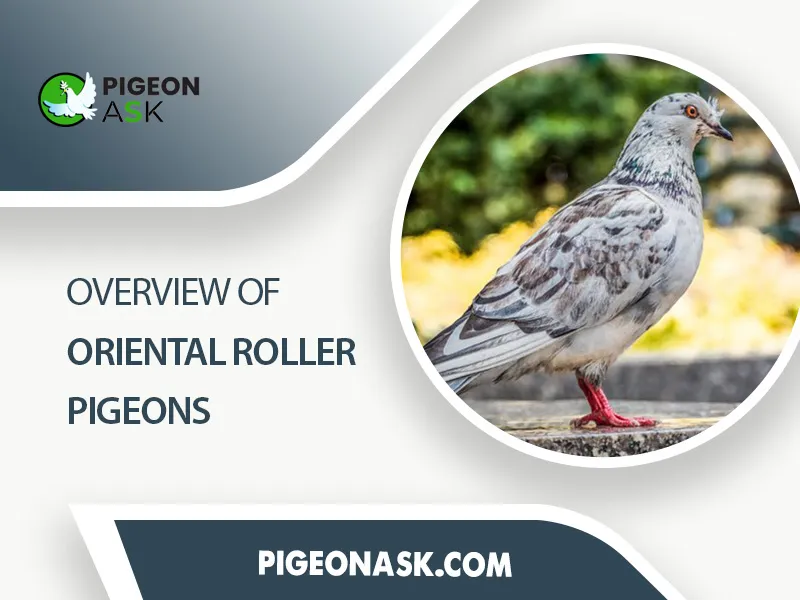
Oriental Rollers are recognizable due to their unique physical features, which include a low-wing carriage and a high-tail carriage.
Supposedly, the origin of the Oriental Roller goes back to 1870. Since then, breeders have developed this breed even further and have used the Oriental Roller to develop the Birmingham Roller pigeon.
History and Origins of Oriental Roller Pigeons
The Oriental Roller pigeon is a descendant of the rock pigeon, developed after years of selective breeding.
It’s also one of the oldest rolling breeds, first developed in regions of Asia or the Middle East. Its origins trace back to Turkey, Syria, Iran, and Pakistan.
Typically, fanciers regard the Oriental Roller as one of the oldest pigeon breeds in the world. It continued to evolve throughout the years, and currently, breeders raise them for their aerial performance capacity.
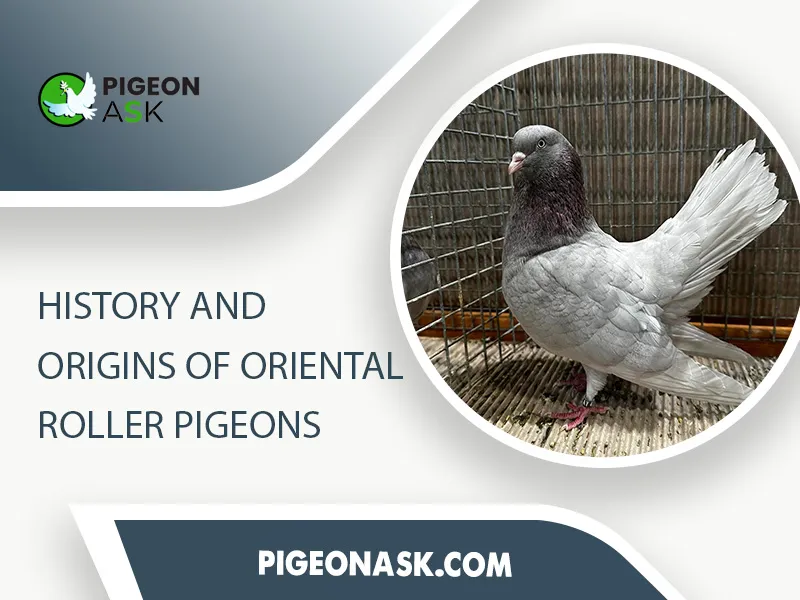
According to recorded documents, breeders imported this pigeon breed into England around 1870, becoming a recognized pigeon breed since.
Then, references indicate that fanciers imported the Oriental Roller from Turkey to the United States around the 1920s decade.
Initially, breeders imported the Oriental Roller pigeon to New York. Over time, this pigeon breed found a home and more popularity in Salt Lake City, Utah, especially during the mid-1930s.
From there, the Oriental Roller pigeon spread to both coasts and is now found all over the country. It’s also a widely popular bird in the United Kingdom.
Interestingly enough, breeders have maintained the original nature of the Oriental Roller. This includes the lack of oil glands and the tails with more feathers than the usual twelve-feathered pigeon tails.
Physical Characteristics and Features
The appearance of Oriental Roller pigeons can be diverse in colors but similar in every other aspect. Here’s how you can identify them.
| Name | Physical Characteristics |
|---|---|
| Head | Small and with an oval shape. |
| Eyes | Large, rounded eyes. Used to be pearl. White Oriental Rollers have dark or bull eyes. |
| Beak | Short and stout. |
| Neck | Short with thick feathers. |
| Wings | Compact wings, kept close to the body and under the tail. |
| Tail | Upturned tail. |
| Legs | Reddish medium-sized legs. |
Absence of Oil Gland
One interesting detail about the Oriental Roller is that this pigeon breed does not have oil glands. Many people believe this “flaw” could affect the birds negatively, but that’s not the case.
Even if Oriental Rollers don’t have an oil duct, they have plenty of oil quills that compensate for it.
Does the Absence of an Oil Gland Leave Oriental Roller Pigeons Susceptible to Harsh Weather?
Another common misconception is that the wings of Oriental Rollers are more vulnerable to water. Nonetheless, this is not true. This bird may look more water-soaked simply because the wings are larger than other breeds.
Unique Features
The Oriental Roller pigeon has a set of unique features and traits that make them different from other pigeon breeds.
- For example, this pigeon breed possesses a distinctive appearance, with a long tail they carry below the upturned tail. Additionally, the Oriental Roller does not have an oil gland, as we discussed in the previous section.
- Another unique aspect of this pigeon breed is its heritage. The origins of the Oriental Roller date back to hundreds of years ago, initially developed in the Middle East and Europe. This long history makes the Oriental Roller one of the oldest breeds with a rich history.
- Lastly, we have to mention the flying patterns of the Oriental Roller as a unique feature. More specifically, the ability of the pigeon to show an individual flying style makes it a good bird for show.
Some Common Variations
The Oriental Roller doesn’t have variations other than in color and pattern. Historically, the standardized color of this bird was black, white and different combinations of almonds.
However, the United States now recognizes this pigeon in other colors, like red, brown and blue.
Distribution And Habitat
Where can you find the Oriental Roller pigeon, and what habitat is the most suitable for raising it? We address these and more questions in this section.
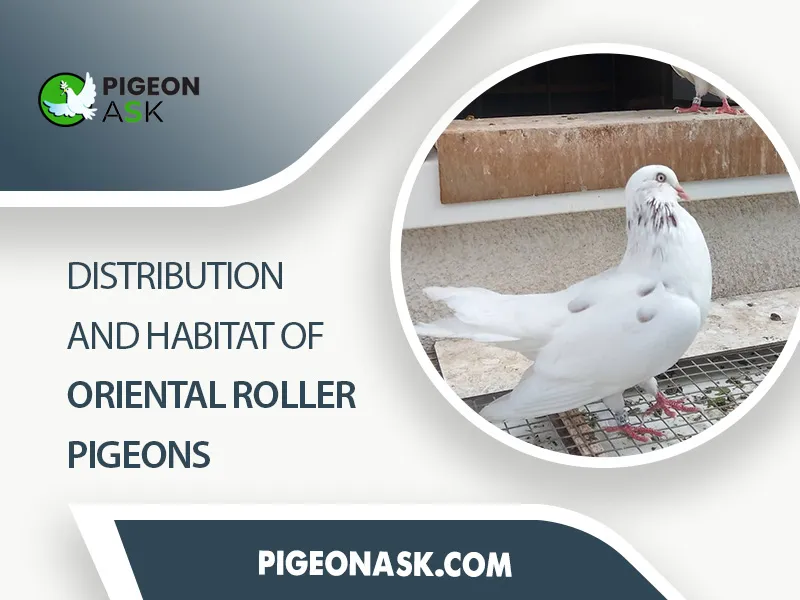
Geographic Distribution
Oriental Roller pigeons have been a prominent bird breed in the United States. Also, this bird is still present in Asia and the Middle East.
Habitat Preferences
Oriental Roller pigeons can thrive in rural and suburban habitats. With this pigeon, you will need plenty of space to let them fly and learn new tricks.
For this reason, an urban environment may pose limitations that could complicate training the Oriental Roller unless you want it as a pet.
Threats and Conservation Status
The Oriental Roller pigeon is under a common conservation status, meaning it’s not an endangered pigeon breed. There’s no significant threat over this bird, and you can find it easily in many areas of the world.
Behavior And Traits of Oriental Roller Pigeons
The Oriental Roller pigeon is a calm bird with a pleasant disposition for training. Once it gets used to humans or if you raise it since birth, this bird feels secure and can be very friendly.
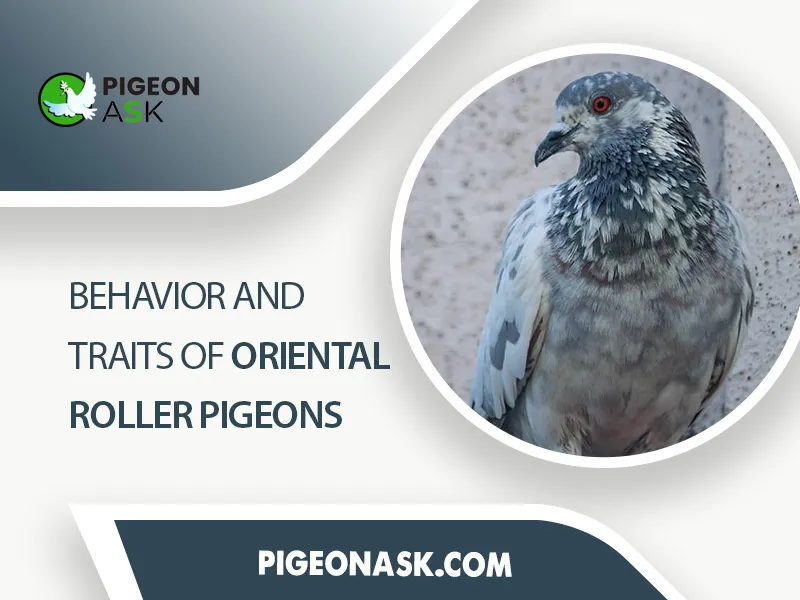
Besides breeders, the Oriental Roller pigeon gets along well with other pigeons and birds.
Differences Between Wild and Domesticated Pigeons
Oriental Roller pigeons are domesticated birds bred and raised indoors. In the wilderness, this pigeon is not likely to survive for long.
Diet
Provide balanced pigeon feed or pellet to ensure your Oriental Rollers receive all the nutrients needed.
In this case, you don’t have to look for intricate food alternatives. This pigeon does well with traditional commercial pigeon feed and you can include seeds and vegetables as extra. Fresh water is equally important, too.
Flight
Flight is the primary reason to breed the Oriental Roller pigeon. After all, this pigeon performs aerial acrobatics that look very natural and impressive.
Some believe these tricks are natural instincts, whereas other breeders allege these maneuvers help the Oriental Roller avoid hawks.
In any case, these beautiful flying patterns have captivated breeders and audiences worldwide for decades.
While flying, the Oriental Roller pigeon can perform somersaults, twists and other fascinating movements.
And even though this breed doesn’t usually fly in a kit like the Birmingham Roller, you can still see small groups of Oriental Rollers taking flight together.
Homing Instinct
Since it’s a roller breed, the Oriental Roller pigeon has a low homing instinct.
Therefore, they’re not birds suitable to fly long distances and should not get too far from the shelter. This limitation means you should be careful while letting them out of the housing.
Courtship, Breeding and Nesting
The Oriental Roller pigeon follows standard breeding seasons to mate and lay eggs. This period consists of March to June and August to November.
Introducing the mating pair during this time is ideal, especially when the weather is warm.
Place the male and female in a separate area for privacy and allow them to court and mate.
After, the female will take approximately two weeks to lay one or two eggs, which will hatch in around 19 days. The male and female interchange incubation duty, making the Oriental Rollers excellent parents.
Nesting
A pigeon nest bowl provides the coziness the Oriental Roller needs to lay and incubate the eggs. Additionally, you can add straw, hay, or small branches to let the pigeons accommodate fully.
Breeding And Maintenance
Maintaining Oriental Roller pigeons is easy. Clean the area regularly and provide water to allow the pigeons to wash themselves. Since the birds do almost everything, you don’t have to interfere that much.
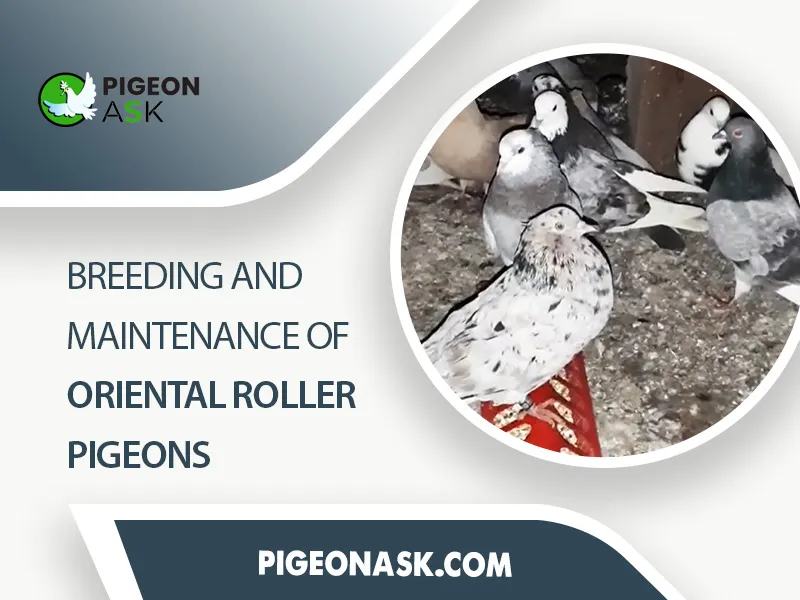
However, you do need to be careful while breeding them. Check out these tips to help you out.
Some Tips and considerations for successful breeding
- Select the mating pair carefully to achieve the desired physical traits. Also, get a pure Oriental Roller pigeon to secure the rolling genetic.
- Consider mixing up a pair of crossbreeds if your goal is to breed crossbreeds. This combination may result in fascinating colors and shapes.
- Socializing helps improve relationships in the flock. Therefore, allow the birds to be around other pigeons and let them fly together.
- Check the young chicks to keep track of their health. Keep them away from heavily dirty areas and ensure the parents take good care of them.
Housing and Feeding
You don’t need to create extraordinary conditions while building a shelter for your Oriental Rollers. Ideally, this pigeon breed will live comfortably in an aviary, pigeon kit box, or a loft.
The essential aspect to remember is that the housing must have proper ventilation and security to protect the birds from predators.
Feeding
Supply your Oriental Rollers with pigeon feed or pellets over a metal tray sheet or similar item early in the morning. Then, you can resupply their food ration throughout the day if the birds eat everything.
Final Word
The Oriental Roller pigeon is the ultimate master of the sky. With an ability to perform multiple tricks, there’s barely any other pigeon breed capable of doing what Oriental Rollers can do.
For this reason, we consider this breed one of the best ones for fancy pigeon breeders. It’s beautiful, intelligent and a spectacle for the eyes.
Like the Oriental Roller, we have a passion for other pigeon breeds with uniquely interesting features and behaviors.
Check out our socials on Facebook, Twitter and Pinterest to learn more about pigeons and birds. We’re waiting for you!
